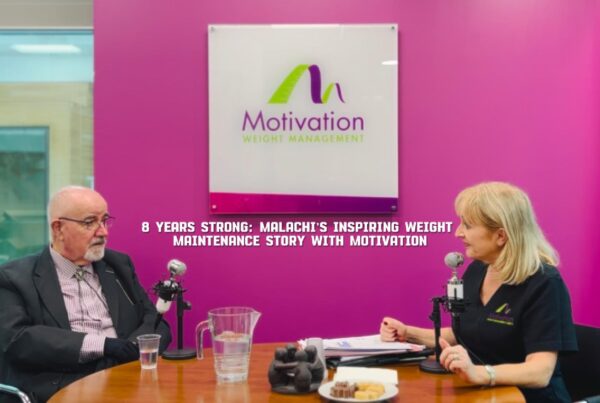
Change – easy to say, but sometimes difficult to achieve. Let’s be honest, lots of us are good at giving lip service to change. We talk about it, think about it and even make half-hearted attempts at it. But, in order to achieve long-term changes, such as weight loss, it’s a bit more complicated.
At Motivation, we know that the public have some awarness of the‘right’ foods to eat, and the importance of taking enough exercise. However, ‘knowing’ what to do is rarely enough. That is why we have dedicated ourselves to years of undestanding the mechanics of long term behavioural change. And it also explains why our one-to-one weight loss coaching is so successful – because it bridges that gap between knowledge and action.
But what is really going on in the brain when we talk about long-term behavioural change? As a first step, we always encourage our clients to think of their ‘Why’? What is motivating or driving them to make changes to their habits? Instead of vaguely answering, ‘I want to be healthier’, we encourage them to tease it out and to get to the real root of why they want to change. Because the bottom line is this – the come into our clinics because they want to change. I would say 99 per cent of the time, they are ready to change – they just need to know how. See more on your WHY here.
A Range of Techniques
Change might not come easily, but psychologists have developed a number of ways to effectively help people change their behaviour. Researchers have also proposed theories to explain how change occurs. Understanding the elements of change, the stages of change, and ways to work through each stage can help you achieve our goals.
Firstly, there are three important elements of change, and most people benefit from writing these out before embarking on a programme of change; first is readiness to change (where are you on this?); second is your own, specific barriers to change (eg. lack of time, lack of support etc..) and third is expected relapse (what might trigger a return to former behaviour and how might you deal with a relapse?).
According to the transtheoretical model, there are five main stages of change: precontemplation, contemplation, preparation for action, action, and maintenance. The Stages of Change model shows that, for most people, a change in behaviour occurs gradually, with the patient moving from being uninterested, unaware or unwilling to make a change (precontemplation), to considering a change (contemplation), to deciding and preparing to make a change. If people are not actually ready to change, we can’t make them – but we can certainly encourage them to think about and step further into the next step in the change process. As part of this, specific, probing questions are asked (see the section entitled, ‘Asking the right questions’).
When an individiual is in action stage, many attempts to maintain the new behaviour occur. However, relapses are almost inevitable and become part of the process of working toward lifelong change. The main tools of relapse prevention is to sign up to regular ‘Maintenance Programme’ visits. We also encourage our clients to use cognitive behavioural therapy (or CBT) techniques in order to challenge distorted thinking and to develop healthier coping skills. We encourage clients to engage in self-care and to use non-food/non-alcohol rewards to help themselves to feel good, including a mind-body relaxation programme to keep stress levels low.
The Best Plan and Strategy for Behavioural Change
Research shows that behavioural approaches are most successful when there is a plan in place. In fact, the key thing to remember is that behavioural change is a skill that can be learnt and practised. Having a programme that has been proven to work is the first step – for instance, we know that deprivation is a bad idea, as people will tend to break out and eat too much if they’re hungry, so one of our main focuses is on an eating plan that helps prevents hunger and stabilises blood sugar.
But we also know that’s not enough. Built into that plan there needs to be a strategy for when an individual has a slip or is finding it hard to push through a plateau and even a mental block. At Motivation, we take all these things into consideration and we’ve covered all bases – mainly because we know behavioural change isn’t easy. In fact, we know that linear weight loss is rare – the reality is we lose weight in a step-wise fashion (ie. we lose some, then we maintain, then we lose some more and so on). Often clients can hit plateaus and that is normal. As are slips and setbacks – they are just part of the journey, and we say that from the very first meeting we have with a client.
Instead, we focus on how to deal with slips – for instance, to ditch the guilt and, instead, to learn from the slip. For instance, did the client have a gap of too long between eating that day, or did they not eat enough protein? If the slip wasn’t due to physiological reasons, perhaps it was down to physchological reasons – for example, were they feeling anxious that day and, if so, how anxious were they? Often people underestimate how powerful their emotions are until they actually have to rate them on a scale of zero to ten.
At Motivation, we encourage clients to see setbacks are a normal part of progress. They are not failures. Setbacks are caused by insufficient coping skills and/or inadequate planning, which are issues that can be fixed. Clients are also encouraged to challenge their thinking by looking at past successes.
When individuals take an all-or-nothing approach, they are more likely to feel overwhelmed and abandon long-term goals in favor of short-term relief. We are highly aware of this, which is why we try highlight tendencies and personality trais that they have that may be unhelfpul, such as perfectionism or excessive guilty thinking. We do this through the monthly mental weight questionnaire (which looks at the habits and attitudes of an individual).
Achieving Goals Leads to Behavioural Change
Setting realistic, measurable goals is crucial. Every goal we achieve, no matter how big or small, means we are making progress – and our brains retain that information, which can trigger motivation to achieve more. Mistakenly, most people think they have to become motivated first, and then they make the changes they want to. But research shows that it is often change itself that motivates us. It can be one simple thing you decide to change – focus on it, and then achieve that to increase your motivation.
The key is to keep the goal REALISTIC. From our experience, it’s crucial that goals are set for the short-term, as these tend to keep us more motivated than a long-term goal. A short-term goal could be, ‘I’m going to go for a jog three times this week’, as opposed to, ‘I’m going to get fit’. Goals also work best when they are specific – such as, ‘I will eat protein every three to four hours’, or ‘I will walk for 45 minutes every second day’. But they also need to be realistic and achievable – this way, we are more likely to stay motivated and succeed.
Asking the Right Questions for Behavioural Change
One of the most effective strategies for bringing about behaviour change is known as ‘motivational interviewing’ (or MI). This methodology assumes that responsibilitiy and capability for change lies within the client themselves. The aim is to encourage the client to discuss any discrepancies, for instance, between what they want (their goals and dreams) and what they do in reality (for instance, keep self-sabotaging by drinking too much alcohol or letting go of any control over food at the weekend). The therapist’s task is to create a set of conditions that will enhance the client’s own motivation for and commitment to change. See an example role-play of MI in action here.
The key thing to realise is that, although an individual might say they are not motivated enough to change, often – and with some probing – they will discover that there are, in fact, reasons they do want to change. It is a matter of weighing up the opposing forces – and to encourage the individual to think about the consequences of NOT changing. This means encouraging them to deal with ambivalence and to successfully manage their own resistance to change.
A useful tool in MI is to ask a client to make a list of pros and cons (benefits/costs) for and against behaviour change. Next, the client could assess the importance and their own confidence in making the change in question (ie. on a scale of zero to ten, how important is this to you? And, again on a scale of zero to ten, how confident are you that you can make this change?
Looking forward, the client could think about their hopes for the future. If they make this particular change, how do they think things would be different? What could possibly be the very best results from making this change? Positive feedback is important. Often when clients make the shift from unhealthy to healthier habits, they quickly see benfits – but it’s important that their coach/adviser draws this out of them along the journey simply by asking ‘What benefits are you experiencing?’ This could be renewed energy, or being able to climb the stairs without getting out of breath. It is a very simple tool that increases motivation along the long journey that is weight loss.
Sustaining Behavioural Change – in the Long Term
To create lasting behavioural change, we must understand that, in general, behaviour doesn’t occur in a vacuum. Instead people decide to change their behaviour because they hope it will help them achieve a specific outcome or goal. We adopt a new behaviour because we believe it serves a specific purpose in our lives.
However, interestingly, research shows that those future outcomes that initially encourage us to change our behaviour may not be the things that actually help us to sustain long term change. In fact, recent research suggests that large future outcomes, like disease prevention, might just be too logical and not emotional enough.
We need to tap into our emotional (rather than logical) brains to keep change going. In other words, we need to focus on feelings, rather than function. Research published in the Journal of Consumer Research in 2013 investigated whether people rely more on their feelings about an outcome from a choice (e.g., How do I feel about exercising at the gym?) than the function of that outcome in their actual decision making (e.g., What do I hope to achieve from exercising?).
This study showed that participants relied more on their feelings, demonstrating that feelings about the outcomes drive our decisions more than the value of the outcome. This piece of research suggests that we would be well advised to shift the frame of reference from the future outcomes from behaviour (eg., better health, weight loss, etc.) to the smaller outcomes that result (less stress, feeling proud of yourself, etc.)
One New York Times columnist, Jane Brody, illustrates this well in an article about how to make exercise a long-term habit.
Reflecting on her own experiences, Brody describes her motivation for exercise; “Weight control may be my first answer, followed by a desire to live long and well. But that’s not what gets me out of bed before dawn to join friends on a morning walk … It’s how these activities make me feel: more energized, less stressed, more productive, more engaged and, yes, happier—better able to smell the roses and cope with the inevitable frustrations of daily life.”
In Summary
We know that there is never one single answer to the challenge that is behaviour change. It takes time and effort, but it is achievable. We know that making small, sustainable changes to behaviour change works the best – so make one small change, and keep it up every day. But also asking the right questions – even of yourself – makes a huge impact on the success or failure of long-term behavioural change.
Discover your ‘Why’ and think beyond the function; try to focus on the feeling that you hope to achieve with this new habit, in order to be successful in the long term. That, combined with the necessary support and positivity from a weight loss coach (particularly one who will challenge clients from time to time) is the perfect recipe for success when it comes to achieving behaviour change.
For more mental tips for successful weight loss and behaviour change, read here.



